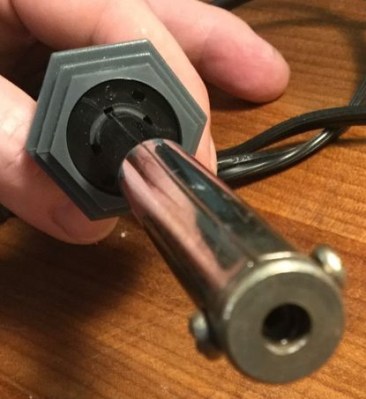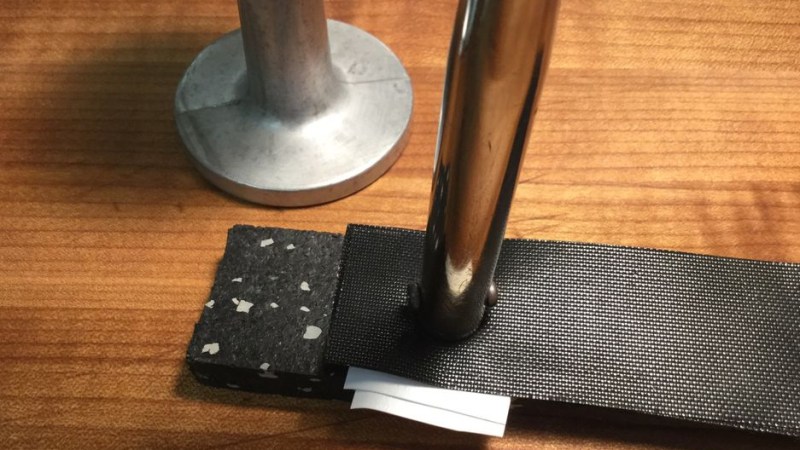Plastic milk bottles, when your project or prototype needs an urgent source of plastic, they are often the first thing to hand. Convenient and flexible, but strong at the same time and usually free, they’re the ultimate source of material in a pinch. However, when it comes to actually manipulating the HDPE plastic they’re made from, there’s often a challenge. It’s easy to cut, but not so easy to join. Conventional glues can have a hard time, making it difficult to bond.

Enter [zimitt], and a spot welding solution for joining HDPE with ease. Ok, so ‘spot welding’ might be a little optimistic given the speed of this process, but it’s useful nonetheless. To heat the plastic, a cheap soldering iron is recommended. A low wattage, straight-to-the-wall one does well, especially as they commonly have the washer-style end shown in the picture. To protect the plastic from burning, a BBQ mat is used – they’re temperature resistant and usually made with a PTFE surface.
First, place the two sheets of plastic face to face and sandwich top and bottom with the BBQ mat. Apply some heat to the mat with the soldering iron then, after a few seconds, remove the iron and provide pressure with a flat object to bond the plastic. [zimitt] used an espresso tamper for this which was ideal.
The results are impressive, and [zimitt] experiments with different plastics as well. Of course, you should exercise caution when attempting anything like this, given the health risks present when heating up different types of plastic.
HDPE is easy to recycle at home, and we’ve seen a lot of great uses: a plastic joiner’s mallet, plastic tiles, and even a filament extruder for 3D printing.

















The problem with a lot of plastic is that it has a memory and the moment you hit a fabricated part with heat it starts changing shape in the most annoying ways.
A simpler solution would probably be friction welding with some spare HIPS 3d printer filament and a dremel, that’s what I use when joining PLA parts anyway.
An industrial way to weld plastics is ultra sonic welding, virtually not using heat.
In the netherlands, milk bottles an a lot of diary products are sold in a pe and paper laminate. As a secondary product, you can get the laminate paper on rolls to cover your floors when renovating your house. It is sturdy, kind of waterproof and flexible. You can join it with two sheets of baking paper and a flat iron. I have used this trick to make a huge bellows for a very large format camera project i’m working on.
https://hack42.nl/wiki/The_Camera (dutch, use google translate)
I have only used this material for its intended purpose so far, but found it interesting nonetheless: It’s basically finished drink carton, with printing and holes for the opening already cut out, and then another, almost black film covering it on both sides. You can see the original print through the dark film (mine is milk for McDonald’s). Where the holes are cut out, there is only the thin film on both sides, so it’s a lot weaker there.
I find your use of this stuff very interesting. The pictures with you in the bellows really show the scale. I have used baking paper and a soldering iron to weld plastic film together (thrash bags and such), I will give this a try sometime.
HDPE is actually quite easy to join if you have a hot air gun and good ventilation (such as a fume extractor). Getting the temperature, dwell time, and air flow correct takes a bit more finesse, as does the application (or not) of filler material, but it’s not hard to figure out with some practice. Been there, done that. Joining thinner material (such as milk jug material) might pose a problem, but it could probably be figured out by someone with patience.
Its like you guys have never seen anything packaged with plastic banding/strapping around the box.
The next time you’re cussing at a clamshell package that’s been sealed in several dots around the perimeter and has to be cut open*, it’s basically this though most spot sealers are ultrasonic rather than thermal.
*This is a feature, not a bug, intended to deter casual theft from the store. Remember the end-user is not the customer for the manufacturer, the store is.
Many large stores take things on consignment basically acting as a warehouse for the manufacturer. The point being loss prevention isn’t in the store’s interest as they hold none of the financial liability but all of the criminal liability (assault, kidnapping / unlawful detainment, or workers comp) for stopping it.
I’ve used a soldering iron to weld together big pieces of plastic greenhouse tarp. It was tricky getting the speed right, but it did the job.
Tiny CRT = viewfinders https://www.youtube.com/watch?v=QOkIBqzpMnU
Agreed about care being used by the casual DIYer doing this at home, as the fumes emitted from many types of plastic can be toxic. Please use caution and wear a mask when undertaking projects like this. Great tips, though!